pennsylvania
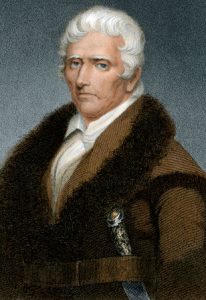 I grew up in a time when western shows were all the rage on television. One show that my family always watched was Daniel Boone. Most people know Daniel Boone from their history classes, as an American frontiersman. Most of his fame stemmed from his exploits during the exploration and settlement of Kentucky. Boone arrived in Kentucky in 1767, about 25 years before it became a state on June 1, 1792. He spent the next 30 years exploring and settling the lands of Kentucky, including carving out the Wilderness Road and building the settlement station of Boonesboro. Without Boone the history of Kentucky would have been much different.
I grew up in a time when western shows were all the rage on television. One show that my family always watched was Daniel Boone. Most people know Daniel Boone from their history classes, as an American frontiersman. Most of his fame stemmed from his exploits during the exploration and settlement of Kentucky. Boone arrived in Kentucky in 1767, about 25 years before it became a state on June 1, 1792. He spent the next 30 years exploring and settling the lands of Kentucky, including carving out the Wilderness Road and building the settlement station of Boonesboro. Without Boone the history of Kentucky would have been much different.
Boone was born near Reading, in Berks County, Pennsylvania, the son of hard-working but adventurous Quaker parents. He learned some blacksmithing, but had very little formal education. Daniel appears to have been a scrappy lad who loved hunting, the wilderness, and independence. When his parents left Pennsylvania in 1750 bound for the Yadkin valley of northwest North Carolina, Daniel went along willingly, because the move fit right in with his spirit of adventure.
Upon arriving in North Carolina, the cutting edge of the frontier, he was able to indulge his hunting prowess and love of the wilderness. In the years that followed, he served as a wagoner with General Edward Braddock’s ill-fated expedition to Fort Duquesne in 1755. Boone then married a neighbor’s daughter, Rebecca Bryan, in 1756, and in 1758 is believed to have been a wagoner with General John Forbes who was hacking out the road to Fort Duquesne, which he rebuilt as Fort Pitt…now Pittsburgh. Back in North Carolina, Daniel purchased land from his father but never seriously engaged in farming. He loved to roam far too much to settle down and farm the land in one place. In 1763 he and his brother Squire journeyed to Florida, but for unknown reasons they did not stay. I guess Kentucky would always be his first love.
Boone was first in eastern Kentucky in 1767, but his expedition of 1769-1771 is more widely known. With a small party Boone advanced along the Warrior’s Path into a beautiful garden-like region. When the time came for the party to return he remained behind in the wilderness until March 1771. On the way home, he and his brother were robbed by Indians of their deer skins and pelts, but the two remained exuberant over the land known as “Kentuck.”
So much did Daniel love that “dark and bloody ground” that he tried to return in 1773, taking forty settlers with him, but the Indians drove them back. The next year he went again into the region carrying a warning of Indian troubles to Governor John Murray Dunmore’s surveyors. As Judge Richard Henderson was concluding the Treaty of Sycamore Shoals. in March 1775, by which much of Kentucky was sold to his Transylvania Company, Boone was hacking out the Wilderness Road. As soon as he reached his destination, he began building Boonesboro, one of several stations, or forts under construction at that time. For the next four years…through 1778…Boone was a captain in the militia, and was busy defending the settlements. His leadership  helped save the three remaining Kentucky stations, Boonesboro, Logan’s (St. Asaph’s), and Harrodsburg. These were years of many ambushes; such as Blue Licks in 1778; captures, including Boone, himself, who was was captured but escaped from the Shawnees; rescues, and desperate defenses.
helped save the three remaining Kentucky stations, Boonesboro, Logan’s (St. Asaph’s), and Harrodsburg. These were years of many ambushes; such as Blue Licks in 1778; captures, including Boone, himself, who was was captured but escaped from the Shawnees; rescues, and desperate defenses.
I knew and have learned much about Daniel Boone over the years, but for me the most interesting thing I have learned is that Daniel Boone is my 5th Cousin 8 times removed, on the Pattan side of my mother, Collene Spencer’s family. It is a small, small world. Today is Daniel Boone Day. It is a day to remember all this great man did for our country.
 Since people began moving around the world there was a need for mail service, but people hated to wait months to hear from their loved ones…especially if it was with bad news. There had to be a way to get he mail faster and with the invention of the airplane, in late 1903, the possibility of a new way to deliver the mail was on the horizon. It really didn’t take very long for someone to make the metal leap from driving the mail to flying the mail from place to place. Where there is a need, there must be a solution. That solution came on May 15, 1918, when the United States officially established airmail service between New York and Washington DC, using Army aircraft and pilots. Prior to this date, the Post Office Department used new transportation systems such as railroads or steamboats to transport mail. They contracted with the owners of the lines to carry the mail. There were no commercial airlines to contract with, so no one had thought about that yet, but that was about to change.
Since people began moving around the world there was a need for mail service, but people hated to wait months to hear from their loved ones…especially if it was with bad news. There had to be a way to get he mail faster and with the invention of the airplane, in late 1903, the possibility of a new way to deliver the mail was on the horizon. It really didn’t take very long for someone to make the metal leap from driving the mail to flying the mail from place to place. Where there is a need, there must be a solution. That solution came on May 15, 1918, when the United States officially established airmail service between New York and Washington DC, using Army aircraft and pilots. Prior to this date, the Post Office Department used new transportation systems such as railroads or steamboats to transport mail. They contracted with the owners of the lines to carry the mail. There were no commercial airlines to contract with, so no one had thought about that yet, but that was about to change.
Army Major Reuben H. Fleet was charged with setting up the first US airmail service, scheduled to operate beginning May 15, 1918 between Washington DC, Philadelphia, Pennsylvania, and New York City. The army pilots chosen to fly that day were Lieutenants Howard Culver, Torrey Webb, Walter Miller and Stephen Bonsal, all chosen by Major Fleet, and Lieutenants James Edgerton and George Boyle, both chosen by postal officials. Edgerton and Boyle had only recently graduated from the flight school at Ellington Field, Texas and neither had more than 60 hours of piloting time. While I’m sure they were a bit nervous, I’m also sure they were excited to be standing on the threshold of history.
The project got off to a bit of an embarrassingly rocky start, when Lieutenant Boyle, who was engaged to the daughter of Interstate Commerce Commissioner Charles McChord, was selected to pilot the first plane out of Washington DC that day. After all his preparations, Boyle hopped into his plane and was unable to start it. The plane had not been fueled. I’m sure that added a bit of nervousness to the situation. Nevertheless, he finally got his Curtiss Jenny, loaded with 124 pounds of airmail, into the air and made his way to Washington DC. His assignment was to fly to Philadelphia, the mid-way stop between the Washington and New York ends of the service. He did not make it there that day. The novice pilot got lost and low on gas, crash landed in rural Maryland, less than 25 miles away from Washington.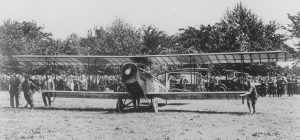
Fortunately for the service, the other flights operated as scheduled that day. Thanks to his political connections, Lieutenant Boyle was given a second chance to fly the airmail out of Washington DC. This time, he was given an escort who flew him out of the city, having given him directions to “follow the Chesapeake Bay” towards Philadelphia. Unfortunately, Boyle followed those instructions too literally, following the curve of the bay over to Maryland’s eastern shore, where he landed, out of fuel again. Not even Boyle’s connections could help him now, and he was removed from the pilots list for the service. I’m sure that didn’t help his standing with his future father-in-law either.
The other rookie pilot, Lieutenant James Edgerton, did much better on his flights and stayed with the service. Edgerton managed to keep his plane aloft during a violent storm that struck while he was on another flight, even as the propeller was pelted by hail. He stayed with the mail service until the next year, and became the Chief of Flying Operations. Then in August, the Post Office Department took over airmail operations with airplanes and civilian pilots of its own. Captain Benjamin Lipsner was named the first superintendent of the U.S. Airmail Service.
The first flight operated by the Post Office Department took off from College Park, Maryland, on August 12, 1918. The destination was New York. Max Miller flew that historic flight. Miller flew the new Curtiss R-4 aircraft. These new planes had more powerful Liberty 400 horsepower engines. Miller was the first pilot hired by the Post Office Department. He died when his plane caught fire and crashed on September 1, 1920. The Post Office Department decided to launch pathfinding flights from New York to Chicago in September 1918. A major obstacle was the Allegheny Mountains, considered by some to be the most dangerous territory on the route. U.S. Airmail Service Superintendent Benjamin Lipsner chose two of his best pilots, Eddie Gardner and Max Miller, for these flights. Eager competitors, Gardner and Miller turned the test into a race. On September 5,  1918, the pair left New York. Miller flew in a Standard airmail plane with a 150-horsepower Hispano-Suiza engine. Gardner followed in a Curtiss R-4 with a 400-horsepower Liberty engine and was accompanied by Eddie Radel, a mechanic. As each pilot landed to refuel or make repairs, he eagerly called Lipsner in Chicago to find out where the other one was. A set of telegrams now in the National Postal Museum tracked their progress. Miller landed in Chicago first, at 6:55 p.m. on September 6. Gardner arrived the next morning, landing at 8:17 at Grant Park. Sometimes it isn’t about the size of the engine I guess. Of course, today, very few people use the postal service, not called “snail mail.” With the internet and texting we have almost instant access to our loved ones.
1918, the pair left New York. Miller flew in a Standard airmail plane with a 150-horsepower Hispano-Suiza engine. Gardner followed in a Curtiss R-4 with a 400-horsepower Liberty engine and was accompanied by Eddie Radel, a mechanic. As each pilot landed to refuel or make repairs, he eagerly called Lipsner in Chicago to find out where the other one was. A set of telegrams now in the National Postal Museum tracked their progress. Miller landed in Chicago first, at 6:55 p.m. on September 6. Gardner arrived the next morning, landing at 8:17 at Grant Park. Sometimes it isn’t about the size of the engine I guess. Of course, today, very few people use the postal service, not called “snail mail.” With the internet and texting we have almost instant access to our loved ones.
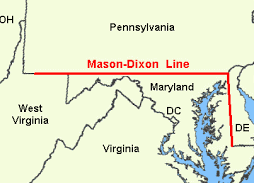
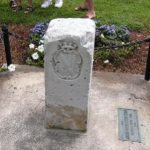 I think most of us have heard of the Mason-Dixon Line, but do we really know what it is and how it came to be called that? Maybe not. It was on October 18, 1767 that two surveyors, Charles Mason and Jeremiah Dixon completed their survey of the boundary between the colonies of Pennsylvania and Maryland, as well as areas that would eventually become the states of Delaware and West Virginia. The Penn and Calvert families had hired Mason and Dixon, two English surveyors, to settle their dispute over the boundary between their two proprietary colonies, Pennsylvania and Maryland. The dispute between the families often resulted in violence between the colonies’ settlers, the British crown demanded that the parties involved hold to an agreement reached in 1732. In 1760, as part of Maryland and Pennsylvania’s adherence to this royal command, Mason and Dixon were asked to determine the exact whereabouts of the boundary between the two colonies. Though both colonies claimed the area between the 39th and 40th parallel, what is now referred to as the Mason-Dixon line finally settled the boundary at a northern latitude of 39 degrees and 43 minutes. The line was marked using stones, with Pennsylvania’s crest on one side and Maryland’s on the other.
I think most of us have heard of the Mason-Dixon Line, but do we really know what it is and how it came to be called that? Maybe not. It was on October 18, 1767 that two surveyors, Charles Mason and Jeremiah Dixon completed their survey of the boundary between the colonies of Pennsylvania and Maryland, as well as areas that would eventually become the states of Delaware and West Virginia. The Penn and Calvert families had hired Mason and Dixon, two English surveyors, to settle their dispute over the boundary between their two proprietary colonies, Pennsylvania and Maryland. The dispute between the families often resulted in violence between the colonies’ settlers, the British crown demanded that the parties involved hold to an agreement reached in 1732. In 1760, as part of Maryland and Pennsylvania’s adherence to this royal command, Mason and Dixon were asked to determine the exact whereabouts of the boundary between the two colonies. Though both colonies claimed the area between the 39th and 40th parallel, what is now referred to as the Mason-Dixon line finally settled the boundary at a northern latitude of 39 degrees and 43 minutes. The line was marked using stones, with Pennsylvania’s crest on one side and Maryland’s on the other.
When Mason and Dixon began their endeavor in 1763, colonists were protesting the Proclamation of 1763, which was intended to prevent colonists from settling beyond the Appalachians and angering Native Americans. In reality, expansion was inevitable, but many in government couldn’t seem to see that. As the Mason and Dixon concluded their survey in 1767, the colonies were engaged in a dispute with the Parliament over the Townshend Acts, which were designed to raise revenue for the British empire by taxing common imports including tea. A protest that resulted in the Boston Tea Party, but that is another story. Twenty years later, in late 1700s, the states south of the Mason-Dixon line would begin arguing for the perpetuation of slavery in the new United States while those north of line hoped to phase out the ownership of human property. This period, which historians consider the era of “The New Republic,” drew to a close with the Missouri Compromise of 1820, which accepted the states south of the line as slave-holding and those north of the line as free. The compromise, along with those that followed it, eventually failed, and slavery was forbidden with the Emancipation Proclamation in 1862.
One hundred years after Mason and Dixon began their effort to chart the boundary, soldiers from opposite 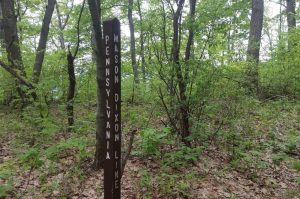
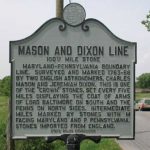 sides of the line spilled their blood on the fields of Gettysburg, Pennsylvania, in the Souths final and fatal attempt to breach the Mason-Dixon line during the Civil War. One hundred and one years after the Mason and Dixon completed their line, the United States finally admitted men of any complexion born within the nation to the rights of citizenship with the ratification of the 14th Amendment…a poorly thought out amendment which continues to cause illegal immigration to this day, due to birth right citizenship.
sides of the line spilled their blood on the fields of Gettysburg, Pennsylvania, in the Souths final and fatal attempt to breach the Mason-Dixon line during the Civil War. One hundred and one years after the Mason and Dixon completed their line, the United States finally admitted men of any complexion born within the nation to the rights of citizenship with the ratification of the 14th Amendment…a poorly thought out amendment which continues to cause illegal immigration to this day, due to birth right citizenship.
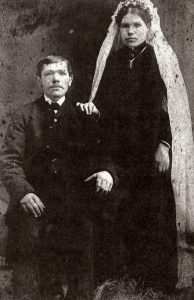 My great grandparents, Henriette and Carl Schumacher were both of German descent. They both came to America at different times…Grandma in 1882 and Grandpa in 1884. They met at a baptism and fell in love. They were married, and had 7 children, one of whom died as a little girl. They were just two of the many German people who have come to this country as far back as the colonial days. Of course, there were many German people who came here before my great grandparents. One of the most notable groups was the 13 German Mennonite families from Krefeld who landed in Philadelphia. These families founded Germantown, Pennsylvania on October 6, 1683. The settlement was the first German establishment in the original thirteen American colonies.
My great grandparents, Henriette and Carl Schumacher were both of German descent. They both came to America at different times…Grandma in 1882 and Grandpa in 1884. They met at a baptism and fell in love. They were married, and had 7 children, one of whom died as a little girl. They were just two of the many German people who have come to this country as far back as the colonial days. Of course, there were many German people who came here before my great grandparents. One of the most notable groups was the 13 German Mennonite families from Krefeld who landed in Philadelphia. These families founded Germantown, Pennsylvania on October 6, 1683. The settlement was the first German establishment in the original thirteen American colonies.
There are many people in the United States who can trace their ancestry back to German roots in one way or another, and the German-American people have been a building block in this nation. These were people who wanted to come here for a better  life, or to escape some of the horrors of the German government, and I for one am thankful that my grandparents immigrated to this country. President Ronald Reagan believed that the German-American heritage was so important to this nation, that in 1983, he proclaimed October 6 as German-American Day to celebrate and honor the 300th anniversary of German American immigration and culture to the United States. On August 6, 1987, Congress approved S.J. Resolution 108, designating October 6, 1987, as German-American Day. It became Public Law 100-104 when President Reagan signed it on August 18, 1987. Proclamation number 5719 was issued on October 2, 1987, by President Reagan in a formal ceremony in the White House Rose Garden, at which time the President called on Americans to observe the Day with appropriate ceremonies and activities. Now for many people, that might include German beer, as well as Oktoberfest activities…basically a party.
life, or to escape some of the horrors of the German government, and I for one am thankful that my grandparents immigrated to this country. President Ronald Reagan believed that the German-American heritage was so important to this nation, that in 1983, he proclaimed October 6 as German-American Day to celebrate and honor the 300th anniversary of German American immigration and culture to the United States. On August 6, 1987, Congress approved S.J. Resolution 108, designating October 6, 1987, as German-American Day. It became Public Law 100-104 when President Reagan signed it on August 18, 1987. Proclamation number 5719 was issued on October 2, 1987, by President Reagan in a formal ceremony in the White House Rose Garden, at which time the President called on Americans to observe the Day with appropriate ceremonies and activities. Now for many people, that might include German beer, as well as Oktoberfest activities…basically a party.
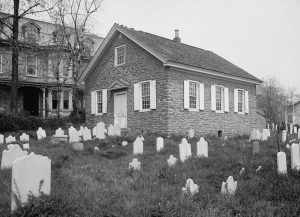 The Germantown, Pennsylvania, settlers organized the first petition in the English colonies to abolish slavery in 1688. Originally known as German Day, the holiday was celebrated for the first time in Philadelphia in 1883, on the occasion of the 200th anniversary of the arrival of the settlers from Krefeld. Similar celebrations developed later in other parts of the country, but the custom died out during World War I as a result of the anti-German sentiment that prevailed at the time. Then, in 1983, President Reagan decided that the time had come to reinstate it. I think it’s a good thing, because those German people who left Germany, were not like the German government was. They were truly good people, who were good for this nation.
The Germantown, Pennsylvania, settlers organized the first petition in the English colonies to abolish slavery in 1688. Originally known as German Day, the holiday was celebrated for the first time in Philadelphia in 1883, on the occasion of the 200th anniversary of the arrival of the settlers from Krefeld. Similar celebrations developed later in other parts of the country, but the custom died out during World War I as a result of the anti-German sentiment that prevailed at the time. Then, in 1983, President Reagan decided that the time had come to reinstate it. I think it’s a good thing, because those German people who left Germany, were not like the German government was. They were truly good people, who were good for this nation.
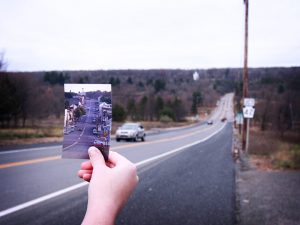
 Sometimes, the best of intentions can go horribly wrong, and when things go wrong, it becomes a disaster, and disaster is exactly what happened in Centralia, Pennsylvania when a fire was set to burn out an old landfill before the Labor Day holiday in 1962. The fire that was started on May 27, 1962, seemed like a simple solution to a big mess, but the landfill was also an old strip-mine pit, connected to a maze of abandoned underground mining tunnels full of coal. No one knows how the fire got to the coal vein below the ground, but once it did, the situation was out of control. Some called it careless trash incineration in a landfill next to an open pit mine, which ignited a coal vein, but no one expected the fire to crawl insidiously along the rich coal deposits that still laid deep in the ground. No one expected the burning coal to vent hot and poisonous gases up into town, through the basements of homes and businesses. Nevertheless, with dawn came the horror, as residents realized that the fire was not going to be extinguished, or in fact, ever burn itself out…at least not until all the interconnected coal veins in eastern Pennsylvania were finally burned out. As the underground fire worked its way under rows of homes and businesses, the threat of fires, asphyxiation, and carbon monoxide poisoning became a daily concern.
Sometimes, the best of intentions can go horribly wrong, and when things go wrong, it becomes a disaster, and disaster is exactly what happened in Centralia, Pennsylvania when a fire was set to burn out an old landfill before the Labor Day holiday in 1962. The fire that was started on May 27, 1962, seemed like a simple solution to a big mess, but the landfill was also an old strip-mine pit, connected to a maze of abandoned underground mining tunnels full of coal. No one knows how the fire got to the coal vein below the ground, but once it did, the situation was out of control. Some called it careless trash incineration in a landfill next to an open pit mine, which ignited a coal vein, but no one expected the fire to crawl insidiously along the rich coal deposits that still laid deep in the ground. No one expected the burning coal to vent hot and poisonous gases up into town, through the basements of homes and businesses. Nevertheless, with dawn came the horror, as residents realized that the fire was not going to be extinguished, or in fact, ever burn itself out…at least not until all the interconnected coal veins in eastern Pennsylvania were finally burned out. As the underground fire worked its way under rows of homes and businesses, the threat of fires, asphyxiation, and carbon monoxide poisoning became a daily concern.
Probably one of the scariest situations was when a young man, Todd Domboski fell into a hot, steaming hole created by mine fire subsidence. He survived his 45 second ordeal by grabbing onto tree roots, and screaming for help until his cousin ran to his aid, reached into the void, and hoisted him out. Many Centralia residents had worried that a calamity like the one that nearly unfolded that Valentine’s Day in 1981. Four years earlier, Domboski’s father had told a reporter, “I guess some kid will have to get killed by the gas or by falling in one of these steamy holes before anyone will call it an emergency.” Never did he imagine that it would be his kid that would fall through and almost lose his life.
After the near tragedy, signs were posted to warn visitors to the Centralia area about the dangers of death by asphyxiation or being swallowed by the ground, but the old mining town of Centralia, Pennsylvania, was once home to more than 1,000 people. People with no place else to go. Now, it’s nothing more than a smoldering ghost town that’s been burning for over half a century. Though the town was able to extinguish the fire above ground, a much bigger inferno burned underneath, and it eventually spread its way under Centralia’s town center. The fire was so widespread, destructive and unending. It’s thought that there’s enough coal underground to fuel the fire for another 250 years. In 1980, a $42 million relocation plan incentivized most of the townspeople to relocate and most of the homes were demolished, leaving only about a dozen holdouts behind. Today, Centralia exists only as an eerie grid of streets, its driveways disappearing into vacant lots. Remains of a picket fence here, a chair spindle there. Still John Lokitis and 11 others who refused to leave, the 
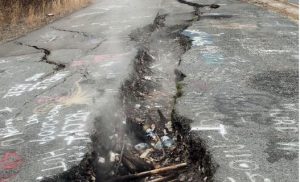 occupants of a dozen scattered structures. Over the decades, the ground has opened up with sulfurous gases sometimes billowing out. The road along Highway 61 swells and cracks open. It is riddled with graffiti and hot to the touch. In the winter, snow melts in patches where the ground is warm. While a few holdouts still live there, I have to wonder what they are thinking. That is like slowly committing suicide, because you refuse to leave the past.
occupants of a dozen scattered structures. Over the decades, the ground has opened up with sulfurous gases sometimes billowing out. The road along Highway 61 swells and cracks open. It is riddled with graffiti and hot to the touch. In the winter, snow melts in patches where the ground is warm. While a few holdouts still live there, I have to wonder what they are thinking. That is like slowly committing suicide, because you refuse to leave the past.
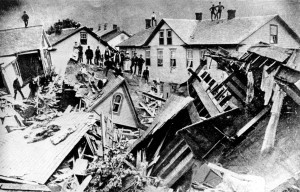 Over the years, man has tried many ways to harness water. Water is a necessity to life, and without it, all things would die off. Some projects worked out better than others, and some simply needed to be replaced sooner than they were in order to prevent disaster. A good example of that is the earthen dam. An earthen dam is a dam that is built out of rocks and dirt, instead of steel and concrete. Of course, when dams were first built, earthen dams were the only way to go, but after so many failed, a new type of dam had to be designed, in order to save lives. One such failure was the earthen dam built in 1840 on the Little Conemaugh River, fourteen miles upstream from Johnstown, Pennsylvania. Johnstown is sixty miles east of Pittsburgh, in a valley near the Allegheny, Little Conemaugh, and Stony Creek Rivers. The area lies in a floodplain that has had frequent disasters. This time would prove to be one of them. At nine hundred by seventy two feet, this dam was the largest earthen dam in the United States, creating the largest man-made lake at that time…Lake Conemaugh. At a time when here were no railroads in the area for transporting goods, the dam and its extensive canal system was the only way to transport goods to the people, but it became obsolete as the railroads replaced the canal as a means of transporting goods. The canal system was left to become a victim of the elements, and with its neglect, also came the neglect of the dam. In reality, people just didn’t really think anything would happen, and they most likely looked at the dam as just a part of the landscape.
Over the years, man has tried many ways to harness water. Water is a necessity to life, and without it, all things would die off. Some projects worked out better than others, and some simply needed to be replaced sooner than they were in order to prevent disaster. A good example of that is the earthen dam. An earthen dam is a dam that is built out of rocks and dirt, instead of steel and concrete. Of course, when dams were first built, earthen dams were the only way to go, but after so many failed, a new type of dam had to be designed, in order to save lives. One such failure was the earthen dam built in 1840 on the Little Conemaugh River, fourteen miles upstream from Johnstown, Pennsylvania. Johnstown is sixty miles east of Pittsburgh, in a valley near the Allegheny, Little Conemaugh, and Stony Creek Rivers. The area lies in a floodplain that has had frequent disasters. This time would prove to be one of them. At nine hundred by seventy two feet, this dam was the largest earthen dam in the United States, creating the largest man-made lake at that time…Lake Conemaugh. At a time when here were no railroads in the area for transporting goods, the dam and its extensive canal system was the only way to transport goods to the people, but it became obsolete as the railroads replaced the canal as a means of transporting goods. The canal system was left to become a victim of the elements, and with its neglect, also came the neglect of the dam. In reality, people just didn’t really think anything would happen, and they most likely looked at the dam as just a part of the landscape.
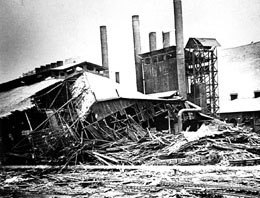
By 1889, Johnstown had grown to a population of 30,000 people, many of whom worked in the steel industry…ironically. On May 30, 1889, it began to rain, and continued steadily all day. No one really gave any thought the potential harm so much rain could bring to the nearly sixty year old earthen dam. The dam had a spillway, and so everything seemed safe, but the spillway became clogged with debris, that could not be dislodged. On May 31, 1889, an engineer at the dam saw the warning signs, but the only way to notify anyone was to ride his horse into the village of South Fork to warn the people…a ride that took an eternity in the face of the impending disaster. Nevertheless, it should have been enough time, but the telegraph lines were down, and no warning ever reached Johnstown. At 3:10pm, the dam collapsed with a roar that could be heard for miles. The water, moving at 40 miles per hour barreled down on the towns in it’s path, wiping out everything that got in its way. At Johnstown, 2,200 people lost their lives that day, including one Thomas Knox and his wife. Thomas, like a large number of the flood victims was never found. While I’m not sure that Thomas Knox is related to my husband, Bob Schulenberg’s family, it is quite likely that he is, as there are a number of Thomas Knox’s in the family…though none that I have found so far that died in the Johnstown Flood.
The people in the path of the raging flood waters, were tossed around, along with all that debris, including thirty three train engines that were pulled into the flood waters. I’m sure that for many, death did not come 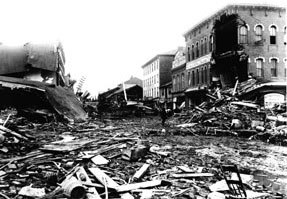 from drowning, but rather from blunt force trauma. Nevertheless, some people did manage to climb atop the debris, only to be burned alive when much of the debris caught fire, when it was caught in a bridge downstreem and burst into flames. There was a report of a baby that survived on the floor of a house that floated 75 miles downstream, but that was something that was not confirmed. It was during the Johnstown flood, that the American Red Cross handled its first major relief effort. Clara Barton arrived five days after the flood to lead the relief. In the end, it took five years to rebuild Johnstown, which went through disastrous floods in 1936 and 1977. I have to wonder if they should just move the town, but with no major floods since 1977, it’s hard to say.
from drowning, but rather from blunt force trauma. Nevertheless, some people did manage to climb atop the debris, only to be burned alive when much of the debris caught fire, when it was caught in a bridge downstreem and burst into flames. There was a report of a baby that survived on the floor of a house that floated 75 miles downstream, but that was something that was not confirmed. It was during the Johnstown flood, that the American Red Cross handled its first major relief effort. Clara Barton arrived five days after the flood to lead the relief. In the end, it took five years to rebuild Johnstown, which went through disastrous floods in 1936 and 1977. I have to wonder if they should just move the town, but with no major floods since 1977, it’s hard to say.
 As a young mother of two daughters, both under 4, there were days when the world seemed a scary place. March 28, 1979 was one of those days. At 4am that March morning, an event took place that changed the way we felt about nuclear power. Suddenly, it became just a little bit dangerous. We were used to power plants, and they had never seemed like anything that could cause great harm. All that changed on March 28, 1979, when a pressure valve in the Unit-2 reactor at Three Mile Island failed to close. Cooling water, contaminated with radiation, drained from the open valve into adjoining buildings, and the core began to dangerously overheat. It was the worst accident in the history of the United States nuclear power industry.
As a young mother of two daughters, both under 4, there were days when the world seemed a scary place. March 28, 1979 was one of those days. At 4am that March morning, an event took place that changed the way we felt about nuclear power. Suddenly, it became just a little bit dangerous. We were used to power plants, and they had never seemed like anything that could cause great harm. All that changed on March 28, 1979, when a pressure valve in the Unit-2 reactor at Three Mile Island failed to close. Cooling water, contaminated with radiation, drained from the open valve into adjoining buildings, and the core began to dangerously overheat. It was the worst accident in the history of the United States nuclear power industry.
The place was the Three Mile Island nuclear power plant. It was built in 1974 on a sandbar on Pennsylvania’s Susquehanna River, just 10 miles downstream from the state capitol in Harrisburg. The second reactor began operating in 1978, and the plant was given rave reviews for generating affordable and reliable energy in a time of energy crisis. Then came disaster. A broken pressure valve started leaking the cooling water, and the emergency cooling pumps automatically went into operation. This process would have taken care of the problem, if not for human intervention. The operators misread the confusing and contradictory readings, and shut down the emergency water system. The reactor was also shut down, but residual heat from the fission process was still being released. The next morning, the core temperature was over 4,000 degrees, just 1,000 degrees short of meltdown. Had a meltdown occurred, deadly radiation would have drifted across the countryside, fatally sickening a potentially great number of people. The plant operators struggled to understand what had happened, while contaminated water was releasing radioactive gases throughout the plant. The radiation levels, were not immediately life threatening to the plant 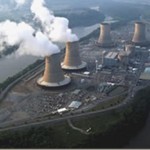 workers, but they were dangerous. The core continued to cook as the contaminated water was contained and precautions were taken to protect the operators.
workers, but they were dangerous. The core continued to cook as the contaminated water was contained and precautions were taken to protect the operators.
Then, about 8am the news leaked to the outside world. The company tried to sugar coat it as much as they could, saying that no one outside the plant was in danger, but when it was discovered that at least a small amount of radiation had leaked to the area, the governor told people to stay in doors as a precaution. The reality was sinking in. This wasn’t as benign as they had tried to make it seem. In the end, I suppose the damage wasn’t great, but it could have been, and I recall feeling just a little less safe.
 I can’t think of Groundhogs Day without thinking of my husband, Bob’s grandmother, Vina Leary Schulenberg Hein, who was born on that day. I don’t suppose that first Groundhog’s Day mattered much to her or to her parents. They were too busy having a new baby to think about whether or not it would be an early spring. I think later on though, Grandma liked sharing her birthday with Groundhog’s Day…at least we all knew that she thought it was special, because she did mention it a few times.
I can’t think of Groundhogs Day without thinking of my husband, Bob’s grandmother, Vina Leary Schulenberg Hein, who was born on that day. I don’t suppose that first Groundhog’s Day mattered much to her or to her parents. They were too busy having a new baby to think about whether or not it would be an early spring. I think later on though, Grandma liked sharing her birthday with Groundhog’s Day…at least we all knew that she thought it was special, because she did mention it a few times.
Groundhog’s Day is one I have a love/hate relationship with. If the groundhog predicts an early Spring, I love the day, but if he predicts six more weeks of winter…I want to slap him. By February, I think most people are ready for Spring to arrive…my sister, Cheryl Masterson being the exception to that rule. Since she loves Winter, the thought of an early Spring is reason to slap the groundhog, but if he promises an early Spring, I’ll gladly protect him from my sister. So fear not Punxsutawney Phil…I’ll save you. If you predict an early Spring, that is. If not…watch out for me!!
Bob’s grandmother would have been 107 this Groundhog’s Day…if she were still with us. I miss her a lot. I was always short on grandparents, because my dad’s dad passed away before my parents were married, and my dad’s mom passed away when I was six months old. Growing up, all we had were my mom’s parents, and they were both gone by 1988. By 2004 all the grandparents were gone, and I miss each and every one of them. I was grateful to have Bob’s grandparents to be my own too. They always made me feel welcome.
 Every year as Groundhog’s Day approaches, I find myself looking for the upcoming weather reports for Punxsutawney, Pennsylvania, since that is where Punxsutawney Phil lives. I have often wondered how a groundhog in Pennsylvania could predict the coming Spring in Wyoming, but they say he does. Nevertheless, every time he predicts six more weeks of Winter, I hope he fails in that years prediction. They say he is never wrong, but I think he certainly could be…especially when we have cloudy weather here, so seeing his shadow would not be an option here. This year they predict partly cloudy weather for Punxsutawney, Pennsylvania, so an early Spring doesn’t seem likely, but I can dream can’t I. Today would have been Grandma Hein’s 107th Groundhog Birthday. Happy birthday in Heaven Grandma. We love and miss you very much.
Every year as Groundhog’s Day approaches, I find myself looking for the upcoming weather reports for Punxsutawney, Pennsylvania, since that is where Punxsutawney Phil lives. I have often wondered how a groundhog in Pennsylvania could predict the coming Spring in Wyoming, but they say he does. Nevertheless, every time he predicts six more weeks of Winter, I hope he fails in that years prediction. They say he is never wrong, but I think he certainly could be…especially when we have cloudy weather here, so seeing his shadow would not be an option here. This year they predict partly cloudy weather for Punxsutawney, Pennsylvania, so an early Spring doesn’t seem likely, but I can dream can’t I. Today would have been Grandma Hein’s 107th Groundhog Birthday. Happy birthday in Heaven Grandma. We love and miss you very much.
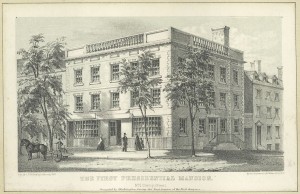
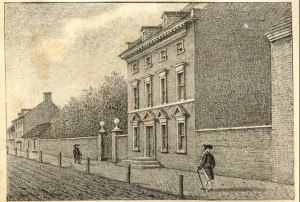 For a time it seemed that our nation couldn’t decide where to put the capitol. The first capitol…for a very short time, was New York City. President George Washington occupied two executive mansions in New York City…the Samuel Osgood House and the Alexander Macomb House. New York began building Government House, but Washington never occupied it. The capitol was moved to Philadelphia. Few people realize that it all began in New York City, nor do they realize that Philadelphia was the first official capitol of the United States. Washington DC became the capitol in December, 1800.
For a time it seemed that our nation couldn’t decide where to put the capitol. The first capitol…for a very short time, was New York City. President George Washington occupied two executive mansions in New York City…the Samuel Osgood House and the Alexander Macomb House. New York began building Government House, but Washington never occupied it. The capitol was moved to Philadelphia. Few people realize that it all began in New York City, nor do they realize that Philadelphia was the first official capitol of the United States. Washington DC became the capitol in December, 1800.
The 1790 Residence Act named Philadelphia the temporary capital for ten years untile the White House could be built on the Potomac River in what is now Washington DC. Philadelphia housed both Continental Congresses and the Constitutional Congress. Both the Declaration of Independence and the Constitution were written in Philadelphia. When it was decided that Washington DC would become the capitol, there was a bit of a fight over the move. While President Washington lived in Philadelphia, he lived in the Market Street mansion, which he altered in ways that may have influenced the White House. In an effort to keep the capitol in Philadelphia, Pennsylvania built a grand presidential mansion a few blocks from the Market Street mansion, but President Washigton declined to occupy it.
President Washington’s term would end before the White House was completed. John Quincy Adams became president and lived in the Market Street mansion from March 1797 to May 1800, having also declined to move into the grand presidential mansion that Pennsylvania had built. Then on June 3, 1800, President Adams moved to Washington DC. The White House was still not finished, so in what I found a shocking move, he moved into the Washington City Hotel, as it was properly named. It was called, and rightfully so, Tunnicliff’s, named after William Tunnicliff, who had it build, and owned it. The Washington City Hotel was in reality, a tavern. A tavern!! That is such a strange place for a US president to choose to live. I’m sure he was excited about 
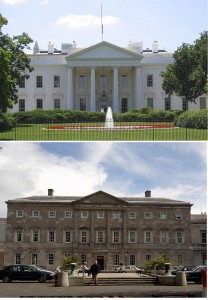 moving into the White House, but it would not be finished unto the end of October. President Adams finally moved into the White House on November 1, 1800, making him the only president to live in the Philadelphia mansion, a tavern, and the White House.
moving into the White House, but it would not be finished unto the end of October. President Adams finally moved into the White House on November 1, 1800, making him the only president to live in the Philadelphia mansion, a tavern, and the White House.
Things were much different in those days, of course. I’m sure that there was no big pre-move check of the tavern and the surrouning area, like there would be now. I suppose that there was security to some degree, but in reality most Americans wouldn’t have even known that the president had moved at that time, much less that he was living in a tavern.
 When your birthday happens to be on a holiday, it can be a special thing. Groundhog Day, 103 years ago was one of those special days. That was the day Bob’s grandmother was born. I don’t know if Grandma’s parents looked at her birthday as something special in those early years or not. For me, however, as her granddaughter-in-law, hers was a birthday that I never forgot. It wasn’t that Groundhog Day was any big holiday where I come from, but for me, the coming of Spring means…well, a return to life!!
When your birthday happens to be on a holiday, it can be a special thing. Groundhog Day, 103 years ago was one of those special days. That was the day Bob’s grandmother was born. I don’t know if Grandma’s parents looked at her birthday as something special in those early years or not. For me, however, as her granddaughter-in-law, hers was a birthday that I never forgot. It wasn’t that Groundhog Day was any big holiday where I come from, but for me, the coming of Spring means…well, a return to life!!
I was curious as to whether or not Groundhog day was even something celebrated when Grandma was born, and since I had never researched it before, I decided to look. I found that Groundhog Day began in 1841 when a German shopkeeper named James Morris in Berks County, Pennsylvania, wrote that February 2 was the day the groundhog comes out of his burrow from hibernating. If the day is sunny and the groundhog sees his shadow, he returns to his burrow for six more weeks of hibernation. If the day is cloudy and the groundhog cannot see his shadow, then he ends his hibernation and the weather will be mild. So it was something that was celebrated when Grandma was born.
Still, I don’t know if her parents gave it much thought or not. What I do know is that for her children and grandchildren, it was a special day. Of course, many people like me look at Groundhog Day as the day we hope will point to an early Spring, but for our family it is also the day a very special lady was born. Grandma was the glue that held the family together in the early years, and the one who taught everyone about love. In the later years, her grandchildren and great grandchildren loved to spend time with her too. She made every visit wonderful…an adventure.
Grandma always liked the fact that her birthday was on Groundhog Day. I remember her telling about her birthday, and you could see it on her face. I think grandma liked the Springtime too. What rancher didn’t. Spring always brought the new life. New cows, the garden growing, being able to get outside and enjoy the day…these were things she liked. Her front yard was a place she liked to be, as was her garden. But the place I remember her the most was in her kitchen. Grandma could easily run circles around most people. When breakfast was over, a short break, and it was time to start preparations for lunch…and then dinner.
Even if Grandma’s birthday had not been on a special day, it would always be a special day to us, her family, because it was the day grandma’s life began. Grandma has been gone for 14 years now, but every year on Groundhog Day, I can see her in my mind’s eye…always busy, always smiling, always special.

